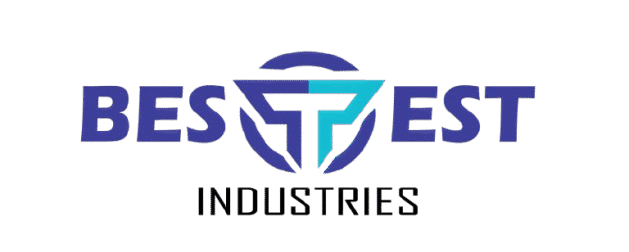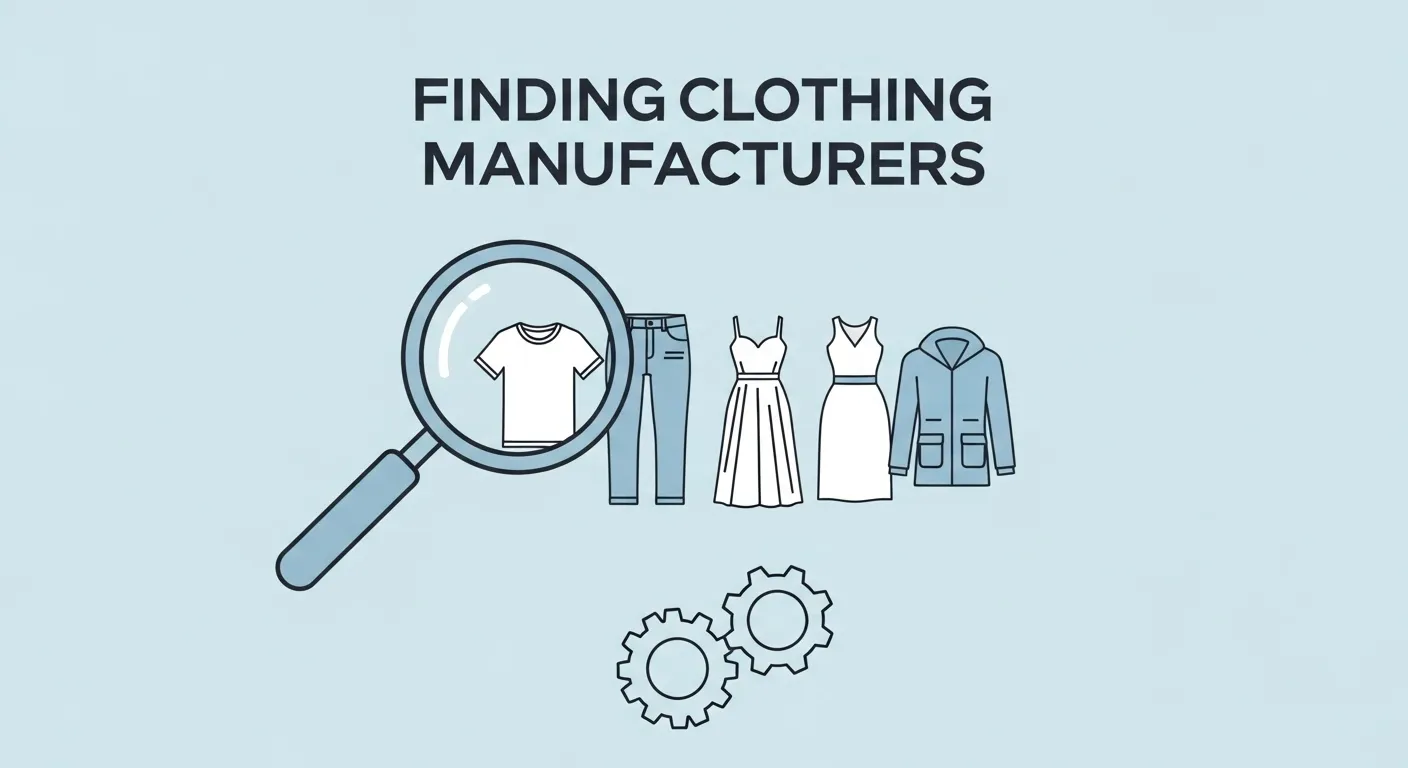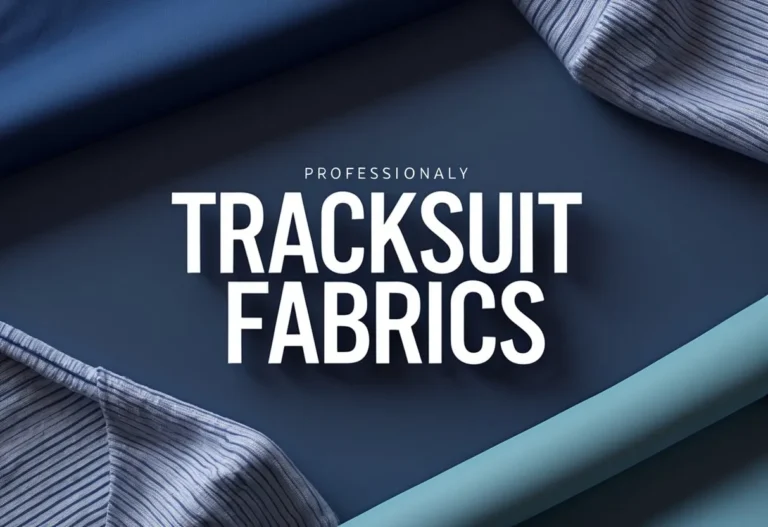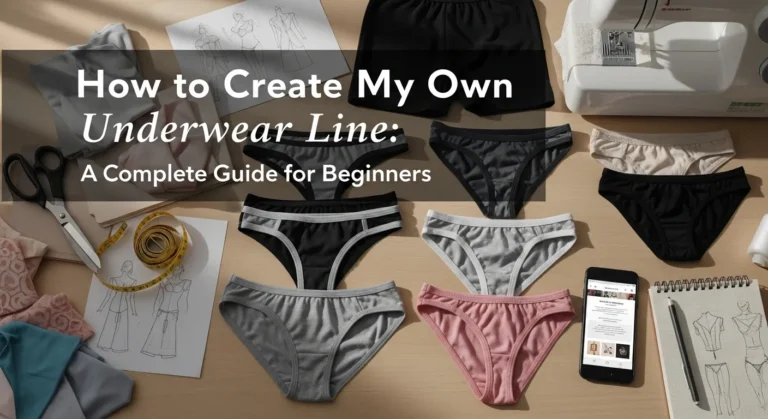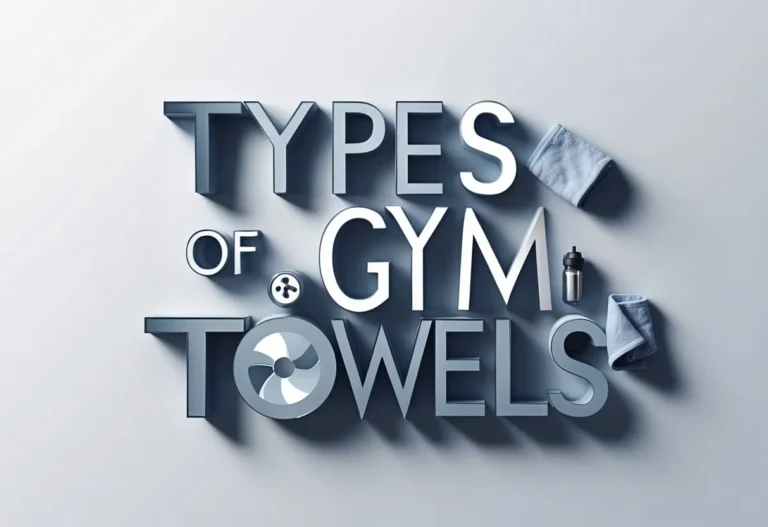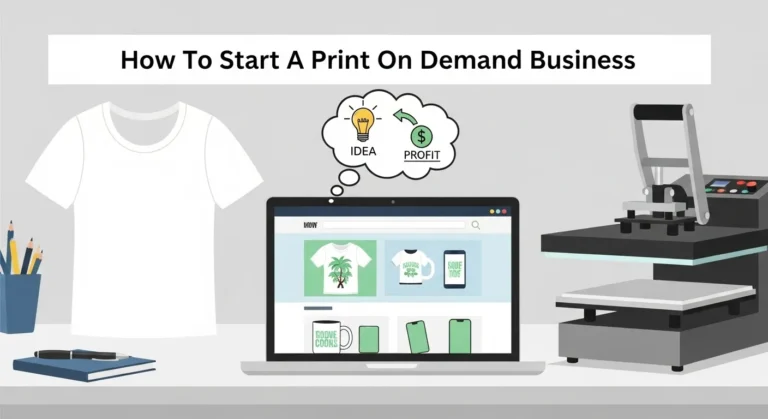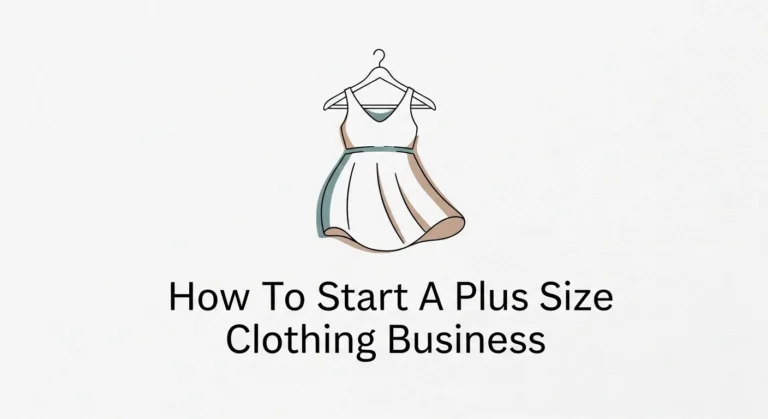How to Find a Clothing Manufacturer: Step-by-Step Guide for Brands
How to Find a Clothing Manufacturer a key step in turning fashion ideas into real products. The process begins by clearly understanding what type of manufacturer fits the brand’s needs, whether it is cut-make-trim services, full-package production, or something more specialized. The best approach involves researching potential partners, preparing clear product details, and choosing a manufacturer with the right experience and capacity.
Knowing whether to work with domestic or overseas manufacturers plays a big role in cost, communication, and quality control. Many start by searching online platforms, attending industry events, or seeking recommendations from other brand owners to find trustworthy factories. Careful vetting helps avoid common issues like poor quality or missed deadlines.
Manufacturers differ in specialization and capabilities, so sending detailed tech packs and asking specific questions helps ensure a good match. This focus on clear communication and thorough preparation creates the foundation for a successful manufacturing partnership.
Key Takeways for How to Find a Clothing Manufacturer
- A clear understanding of production needs guides the search for the right manufacturer.
- Researching and vetting options improves the chance of finding a quality manufacturing partner.
- Detailed communication and product materials help secure accurate quotes and samples.
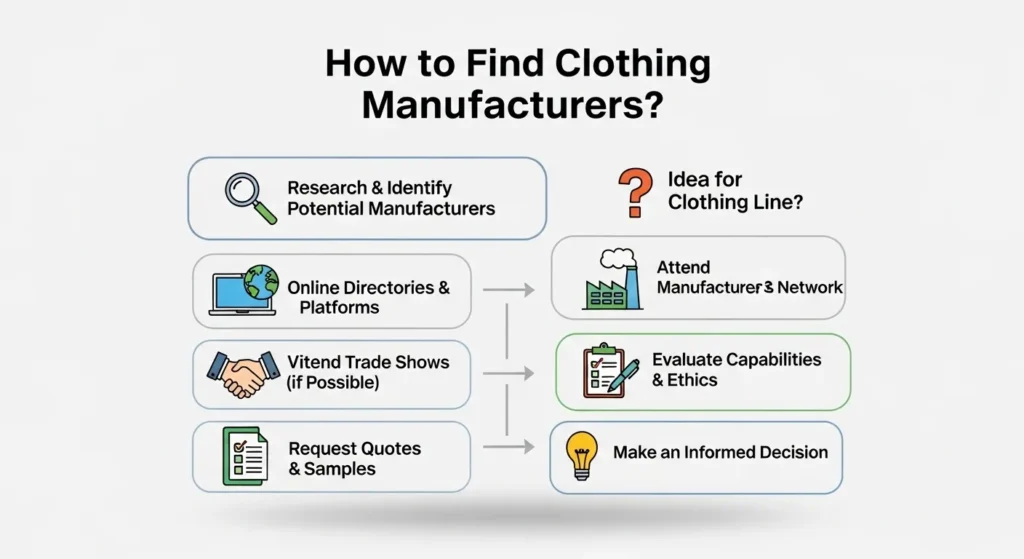
Defining Your Clothing Brand’s Needs
Understanding the specific needs of a clothing brand helps in choosing the right manufacturing partner. Clear details about product type, quality, budget, and order size guide the search and make discussions with manufacturers more effective.
Clarifying Product Type and Design
The type of clothing a brand produces shapes which manufacturers to consider. Knits, wovens, sportswear, or outerwear all require different skills and equipment. Complex designs with unique finishes or embellishments need highly skilled factories.
Brands must decide if their products use custom materials or standard fabrics. This affects sourcing and production time. Clear tech packs and design details reduce errors and miscommunication. Knowing the product type also helps in evaluating if a factory can handle the workload and quality expectations.
Setting Quality Standards and Expectations
Setting quality standards early ensures the brand’s vision matches the manufacturer’s output. This includes fabric quality, construction details, stitching, and finishing touches. Clear quality benchmarks prevent issues like defects or inconsistency.
A brand can request samples or pre-production prototypes for approval. Defining acceptable tolerance levels for defects helps manufacturers understand expectations. Consistent quality improves customer satisfaction and protects the brand’s reputation in the long run.
Establishing Budget and Target Cost
Budget limits and target costs per item guide the choice of manufacturer and materials. Brands need to consider fabric costs, labor, shipping, and potential tariffs or duties. Hidden fees like setup charges or molds must be factored in.
Manufacturers may offer lower prices for larger orders, so understanding how costs change with volume helps budgeting. A realistic budget prevents compromises on quality and avoids unexpected expenses during production.
Determining Minimum Order Quantities
Minimum order quantities (MOQs) define the smallest batch a manufacturer will produce. This impacts inventory, cash flow, and flexibility. Startups often prefer lower MOQs to test markets, while established brands benefit from economies of scale with larger orders.
MOQs vary widely among manufacturers and product types. Brands should verify if MOQs fit their sales expectations and storage capacity. Negotiating flexible MOQs or exploring small-batch producers can reduce risks without sacrificing growth potential.
Preparing Essential Materials for Manufacturers

Having the right documents ready helps clothing manufacturers understand the product clearly. Detailed instructions about design, materials, and deadlines reduce mistakes and speed up production.
Creating a Detailed Tech Pack
A tech pack is a blueprint for the garment. It includes drawings, measurements, fabric types, stitching details, and color codes. This document guides the manufacturer step-by-step.
Clear tech packs prevent confusion. They should have:
- Flat sketches from multiple angles
- Measurement charts with tolerances
- Fabric and trim specifications (type, weight, color)
- Construction details like seam types and stitch counts
- Labels and tags placement
Manufacturers rely on this to make accurate samples. A well-prepared tech pack reduces back-and-forth and helps speed production.
Developing a Bill of Materials
The Bill of Materials (BOM) lists every component needed to create the garment. This includes fabrics, buttons, zippers, thread, labels, and packaging.
Each item in the BOM should have:
- Exact descriptions (material, color, supplier if known)
- Quantities per unit and total order
- Supplier contacts when possible
A thorough BOM helps manufacturers source materials correctly. It also affects pricing and inventory planning, ensuring everything arrives on time to avoid delays.
Specifying Production Timelines
Setting clear timelines is critical for meeting deadlines and managing expectations. This includes deadlines for sample approval, production start, quality checks, and final delivery.
Timelines should cover:
- Sample creation and approval dates
- Bulk production lead times based on order size
- Inspection and shipping schedules
Manufacturers need realistic deadlines that consider their capacity. Clear timelines help prevent surprises and allow brands to plan product launches or sales accurately.
Understanding Domestic vs. Overseas Manufacturing

Choosing between domestic and overseas manufacturing affects cost, quality control, timelines, and communication. Each option has distinct benefits and challenges that impact production scale and the relationship with the clothing manufacturer.
Benefits of Local Manufacturers
Local garment manufacturers offer more control over production quality and timing. Being in the same country often means faster shipping and easier factory visits. This makes it simpler to check samples and solve issues quickly.
Domestic manufacturing usually requires a lower minimum order quantity (MOQ), which suits startups or small brands testing new products. Communication is clearer due to shared language and time zones, reducing misunderstandings.
Local manufacturers also provide stronger legal protections for designs and intellectual property. The trade-off is typically a higher cost per unit, but the benefits in speed and quality oversight often justify the expense for many brands.
Advantages and Challenges of Overseas Manufacturers
Overseas clothing manufacturers usually offer lower costs per item, which helps brands focusing on large production runs to keep budgets manageable. Many factories abroad can handle big orders efficiently, supporting scalability for growing clothing brands.
However, overseas production poses challenges such as longer shipping times and higher shipping costs. Customs delays are common and can affect deadlines. Communication can be difficult because of time zone differences and possible language barriers.
Quality control is harder when the factory is far away, often requiring third-party inspections. Intellectual property protections may also be weaker, so contracts need to be very clear and thorough to safeguard designs.
Scalability and Communication Considerations
Scalability depends on the manufacturer’s capacity and how well they handle increasing order sizes. Overseas garment manufacturers often excel in scaling large volumes. But this comes with the need for careful planning to manage longer production timelines.
Domestic manufacturers typically support smaller runs with faster turnaround, but they may have limits on how much they can increase production. If fast scaling is needed, overseas options might be better, provided the brand accepts added complexity.
Clear communication is crucial. Domestic partners usually offer easier, real-time conversations. Overseas partners require more patience and structured communication to avoid mistakes. Brands should assess their ability to manage remote relationships before choosing overseas manufacturers.
Where to Find Clothing Manufacturers Online
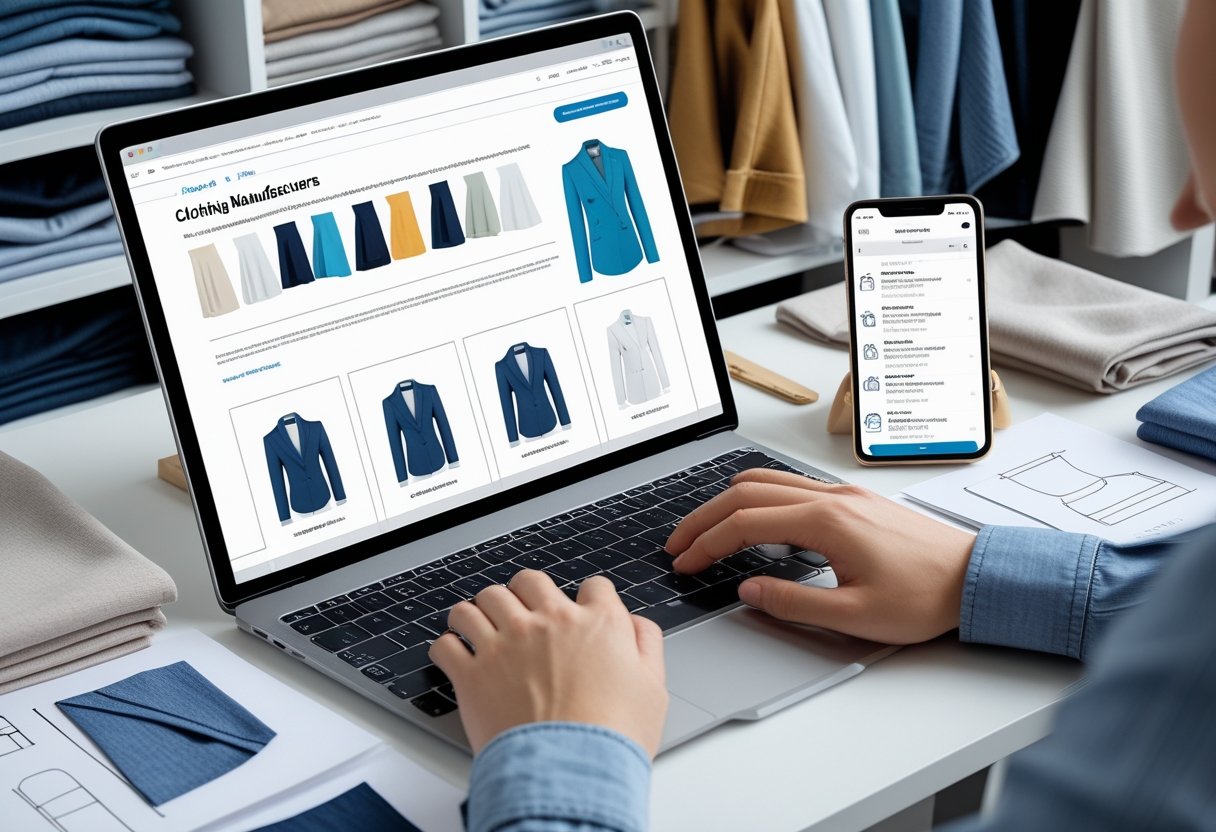
Finding a reliable clothing manufacturer online requires targeting places where verified factories list their services and where industry conversations happen. It is important to filter options by location, product type, and order size to narrow down the search efficiently.
Using Online Directories and Platforms
Online directories like Alibaba, Maker’s Row, and Sewport are popular starting points. They offer large databases of manufacturers from various countries and provide filters like minimum order quantity (MOQ), specialties, and certification status.
Alibaba is known for a wide range of overseas manufacturers, often with larger MOQs. It suits brands looking for cost-effective production but requires careful vetting.
Maker’s Row focuses more on domestic U.S. manufacturers, good for startups needing smaller orders and quicker communication.
Sewport connects buyers with vetted factories worldwide and allows tracking order progress.
Websites like Universetextiles.com specialize in custom fabric sourcing, which can be useful for brands seeking unique materials or custom clothing manufacturers. Preparing a detailed tech pack before contacting factories on these platforms helps get accurate quotes and samples.
Leveraging Social Media and Search Engines
Social media platforms like Instagram and LinkedIn are valuable for discovering manufacturers and seeing their real work. Searching hashtags like #clothingmanufacturer or #apparelfactory on Instagram can reveal factories and their production environments.
LinkedIn offers a way to connect with factory owners and managers directly, allowing for personal communication and background checks.
Using search engines effectively means refining queries to specific needs, such as “low MOQ cut and sew manufacturer USA” or “sustainable t-shirt manufacturer Europe.” This method often uncovers smaller, high-quality factories that may not rank highly in directories.
Engaging in community forums on platforms like Reddit provides peer reviews and real experiences with manufacturers, helping avoid unreliable factories. This approach should always include checking factory credentials and requesting references to ensure reliability.
Connecting at Trade Shows and Industry Events
Trade shows and industry events provide direct access to manufacturers, allowing businesses to see samples, ask questions, and build trust. These events vary from large international gatherings to smaller regional or niche-specific shows that target particular segments of the fashion industry.
Major International Trade Shows
Large global events like Texworld and MAGIC are key places for meeting clothing manufacturers. Texworld brings together fabric suppliers, manufacturers, and designers under one roof, focusing on textiles and production services. MAGIC is one of the biggest trade shows in the U.S. for fashion, showcasing apparel manufacturers, suppliers, and brands from around the world.
These shows offer opportunities to:
- Inspect fabric quality and garment samples in person
- Discuss production timelines and customization options directly
- Network with industry professionals from multiple countries
Attending a major trade show often means access to a wide range of clothing manufacturing services, helping businesses find partners that match their production needs and ethical standards.
Regional and Industry-Specific Events
Smaller events focus on local or specialized parts of the clothing industry. Regional trade shows help find nearby manufacturers, which may offer faster communication and easier quality control. These events often provide a more intimate setting, making networking simpler and more personal.
Industry-specific events target niches, such as sustainable fashion or technical apparel. These allow businesses to connect with manufacturers who have expertise in those areas. Participating in these events can lead to partnerships with manufacturers that align with specific brand values or production requirements.
These events are valuable for startups and small businesses looking for customized solutions or local production partners.
Top 5 Clothing Manufacturers For You
Finding the right clothing manufacturer can be challenging. Here are five reputable companies that offer quality production and reliable service.
Bestest Industries is known for quick turnaround times. They handle large orders and provide good customer support. Brands looking for efficient production and scalability often choose Zega.
Baagh Enterprises focuses on sustainable and ethical manufacturing. They work well with brands aiming for eco-friendly products. Their attention to detail and use of organic materials make them a good choice for green fashion.
Nofal Apparel specializes in custom designs and small-batch production. This manufacturer is ideal for startups and custom projects. They help brands maintain quality without requiring huge minimum orders.
Tack Apparel offers strong quality control and competitive pricing. Their expertise lies in mass production of casual and sportswear. Companies needing consistent quality at scale tend to prefer Tack Apparel.
Appareify provides end-to-end services from design to shipping. They support startups with easy communication and flexibility. Brands benefit from their hands-on approach, especially those new to manufacturing.
| Manufacturer | Strength | Best For |
|---|---|---|
| Baagh Enterprises | Sustainability | Eco-friendly brands |
| Zega Apparel | Fast production | Large orders & scalability |
| Nofal Apparel | Small-batch/custom work | Startups & custom designs |
| Tack Apparel | Quality & pricing | Mass production |
| Appareify | Full-service support | New brands & flexible needs |
Each of these manufacturers has different strengths. Choosing one depends on the brand’s needs, order size, and production goals.
Frequently Asked Questions
How to Find a Clothing Manufacturer involves careful research, clear communication, and understanding key business terms. It is important to focus on quality, costs, production speed, and ethical standards while maintaining control over your brand’s designs.
What are the best practices for vetting clothing manufacturers?
Start by verifying a manufacturer’s experience with similar garments. Request product samples and check quality closely. Look for certifications or industry references that prove their credibility.
Communication is important. Make sure they respond clearly and quickly. Watch out for vague answers or unrealistic promises about price and delivery.
Can you provide tips on negotiating with apparel producers?
Set clear terms on pricing, payment schedules, and delivery timelines before signing. Be upfront about your quality expectations and penalties for delays or defects.
Aim for a fair deal that benefits both parties. Avoid pushing too hard for the lowest price, as it can affect quality and reliability.
What are the key factors to consider when choosing a location for manufacturing?
Domestic manufacturers allow easier communication and faster turnaround times. Overseas factories usually offer lower costs but may require larger minimum orders and longer shipping times.
Consider import fees, your budget, and how important quick production is to your brand.
How do I ensure the manufacturer adheres to ethical and sustainable practices?
Ask for proof of compliance with labor laws and safety standards. If possible, visit the factory or hire a third-party inspector to check working conditions and environmental policies.
Look for certifications related to sustainability and ethical production.
What steps should I take to protect my designs when working with a manufacturer?
Share only necessary information initially, like a spec sheet or reference images. Use nondisclosure agreements (NDAs) to legally protect your ideas.
Hold off on sharing full tech packs until you trust the manufacturer and have a clear contract.
What is the difference between domestic and overseas clothing manufacturers?
Domestic manufacturers provide faster communication and shorter shipping times. They usually have higher costs and smaller minimum order requirements.
Overseas manufacturers often offer cheaper production but may demand larger orders and involve longer lead times due to shipping and customs.
